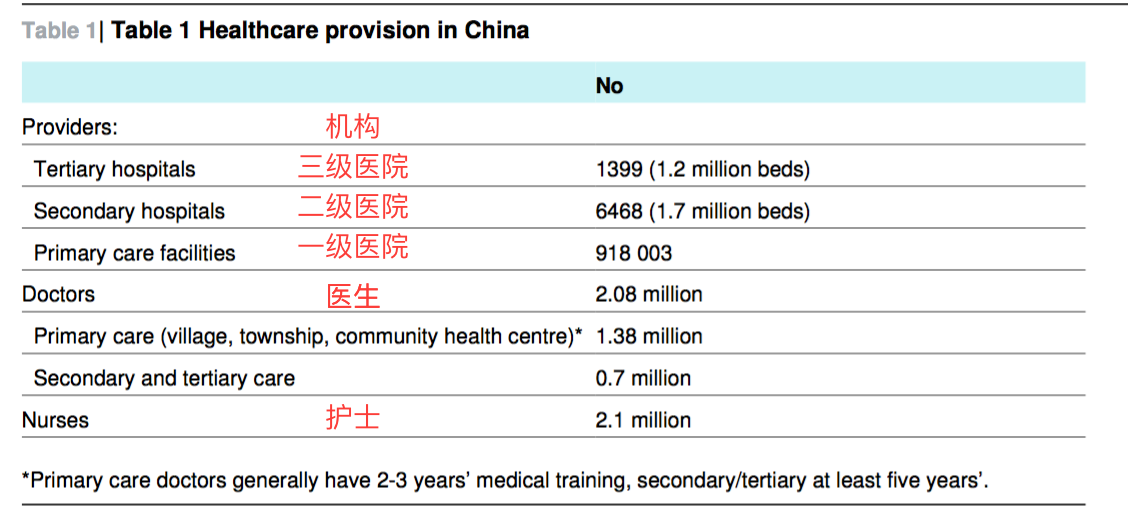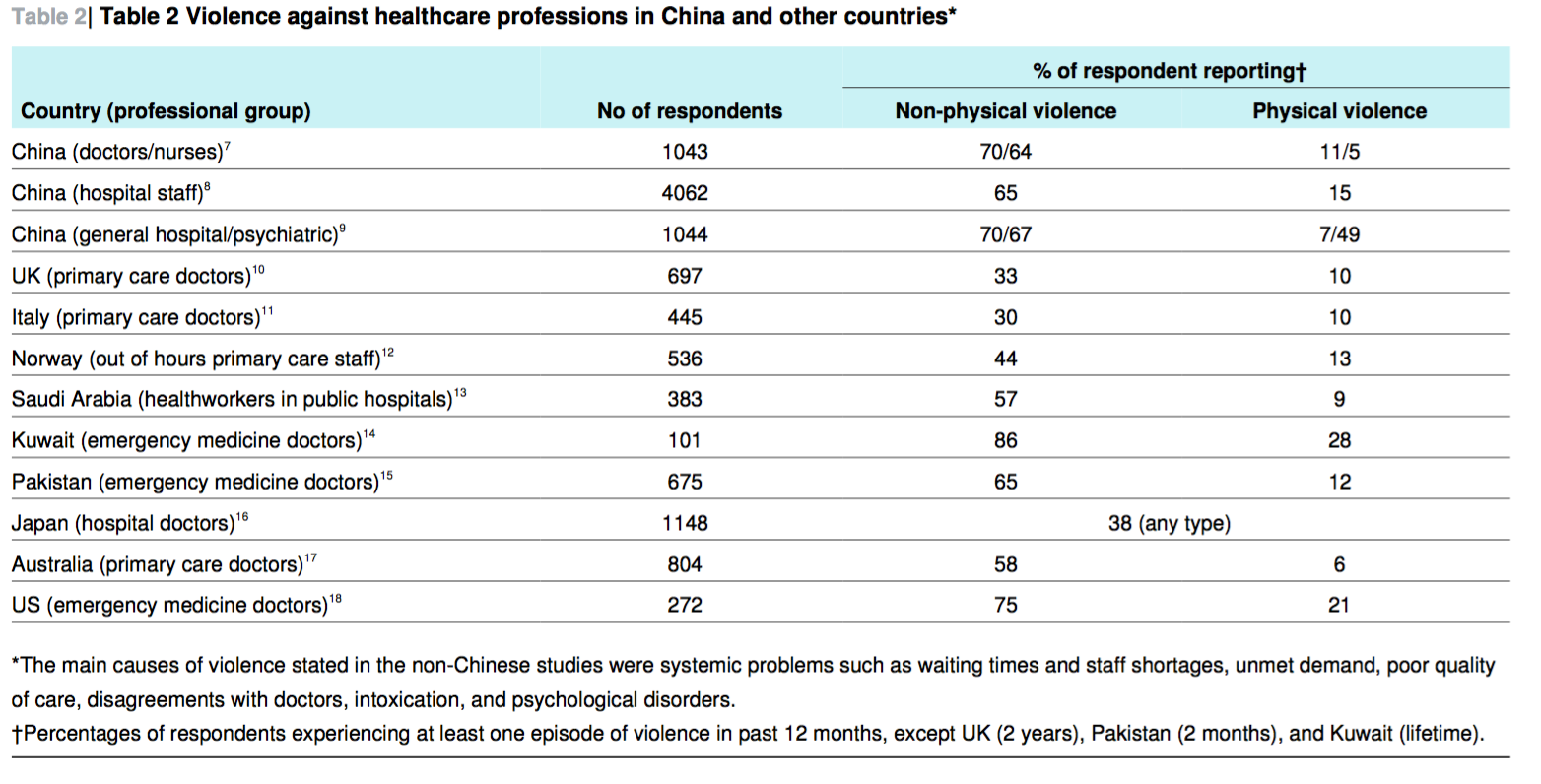中国伤医事件的文献翻译
魏则西的事件将舆论的矛头指向莆田系医院、百度竞价排名和政府对医疗机构的监管。同时,另一起伤医事件以及网友的留言引起了广泛关注。于是,看了一些文献、查了一些资料,记录在这里。
患者对医生的不满早已经存在
On 23 March 2012 a 17 year old boy with ankylosing spondylitis and tuberculosis was refused infliximab by a senior rheumatologist at the First Affiliated Hospital of Harbin Medical University in northern China. He left the clinic, but quickly returned with a knife, and fatally stabbed Wang Hao, a junior doctor who was uninvolved in his case. Three other doctors were injured in the attack.
在2012年3月23日,伴有强直性脊柱炎和肺结核的男孩,在中国北部的哈尔滨医科大学附属第一医院,拒绝了高级风湿科医生的药物infliximab。他离开了医院,但是返回了,拿了一把刀刺死了实习医生王浩,一个与他的病情毫不相关的人。其他的三名医生也在此事件中受伤。
The murder of Wang Hao has particularly unnerved the medical profession and the authorities, partly because of the youth of the perpetrator and the apparent premeditation, but also because of the public’s reaction to it. An online poll, set up by the People’s Daily, the Communist Party mouthpiece, asked readers to express their feelings about the murder using emoticons. Although the 6161 who responded are unrepresentative of the general population (given the readership of the paper and the type of person likely to respond to such polls), the overwhelming majority (65%) selected happiness, with anger second at just 14%, and sadness at only 6.8%.
王浩的这起事件引起了医生和政府极大的不安,部分因为这个伤人者的年轻和明显的预谋,也因为公众对于此事的反应。在一个由人民日报设置的网络调查中,网站要求读者用表情符号表达对于此事件的看法。尽管6161个人的反应无法代表整个群体(考虑到报纸的读者群和愿意参与调查的读者的类型),然而压倒性的比例(65%)选择了高兴,14%的人选择了生气,只有6.8%的人选择了难过。
伤医事件并不仅仅存在于中国
The Ministry of Health reported that in 2006 there were 9831 “major disturbances” involving physical violence in Chinese health facilities, but by 2010 this number had increased to 17 243. However, these figures need to be viewed in the context of a country with around 8000 secondary and tertiary facilities and nearly a million primary care facilities (table 1).
2006年卫生部报道了9831起发生在中国医疗机构的涉及暴力的扰乱时间,到2010年,这一数字增加到17243。然而,这个数据应该要从实际环境考虑,这个是一个有着8000个二级和三级医院、以及接近1百万个一级服务机构的国家。

The few published surveys of experiences of health workers provide further evidence on the scale of the problem.6 Table 2 summarises the results of surveys from China 7-9 together with recent studies from other countries.
很少有发表的针对于医疗工作者的调查能对这个问题的规模提供进一步的证据。表2总结了中国的一些调查的结果以及其他国家的一些研究。
The table does show that violence against health workers is common in all the countries studied, the specialities at most risk (and most studied) being emergency medicine, general practice, and psychiatry. Many of the studies, including those in China, note that aggression against health workers greatly exceeds that against other professional groups.
表格显示,针对于医疗工作者的暴力在各个被研究的国家中均是普遍的,危险最大的(被最多研究的)专家是急诊,全科和神经科。包括中国在内的很多研究都提出对医疗工作的伤害远大于对其他行业人员的伤害。

伤医事件的原因需要系统的改变
At the heart of the problem is a deteriorating doctor-patient relationship, caused by the shortcomings of the health system. Since the introduction of market reforms in the early 1980s, healthcare in China has been commodified.20 Even if people have health insurance, it only partially reimburses the high costs, so healthcare is hard to afford for many. The average inpatient stay will cost more than three to four months of a manual worker’s salary (box). Substantial mark-ups are allowed on drugs and investigations, giving incentives for doctors to profit from tests and treatments that may be unnecessary21 and leaving patients feeling exploited
医患关系恶化的核心问题是由于医疗系统的缺陷。自从上世纪80年代引入市场机制改革,中国的医疗服务就被商品化了。尽管人们享有医保,然而它只能偿还高额费用的一部分,医疗服务对于很多人负担不起。平均的住院花费是手工劳动者3~4个月的工资(box)。药品和研究的大幅提价给了医生在不必要的测试和治疗过程中盈利的诱惑,同时使得病人感觉自己被开采。

Another problem is that Chinese people tend to seek high level care even for minor, self limiting conditions. Since they do not need to get referral from primary care, patients present at secondary and tertiary facilities with often unrealistic expectations. Expensive new drugs and technologies are expected to work and when treatment fails, doctors are deemed responsible.21 Sensationalist media reports about incidents of poor medical practice and failings in the health system have succeeded in fuelling public distrust and anger against the medical profession.
另一个问题是,中国人对于小的自限性的情况也倾向于寻求高水平的医疗服务。由于他们不需要经过一级机构的转诊,病人经常出现在二级和三级医院中,带有不实际的期望。昂贵的新药和新技术被认为是有效的,而当治疗失败时,医生被认为应该负责。哗众取宠的媒体报道了在医疗系统中差的医疗实践和失败的案例,会使得公众对医生的不信任和生气火上浇油。
Doctors are also unhappy. In a recent Ministry of Health report, about 80% of doctors in secondary and tertiary facilities describe themselves as overworked and underpaid, and morale is low. This not only leads to rushed, indifferent, and disrespectful treatment of patients, a major cause of doctor-patient tension, but also increases doctors’ susceptibility to bribes. Many patients resent the perceived necessity to pay high under-the-counter payments to get better treatment.
医生也并不开心。在最近卫生部的报告中显示,大约80%在二级和三级单位的医生认为自己过度工作、薪水过少、精神不振。这不仅导致了对患者的匆忙的、漠不关心的、不尊重的治疗,也增加了医生对于收红包的可能性。许多患者都对“私下送红包是得到更好治疗所必须的”这种观点表示憎恨。
Patients who feel aggrieved about treatment are often forced to take matters into their own hands. Existing legal channels for suing for malpractice, which operate through the local medical association are inefficient, ineffective, and perceived to be weighted in favour of the medical establishment.23 In addition, because hospitals hold the malpractice insurance for their staff (it is not held by individual doctors through a medical defence organisation), hospitals are an easy target for threats and extortion.
对于治疗感到受侵害的患者往往被迫只能自己亲自动手。目前现存通过当地医疗协会诉讼治疗不当的法律途径是不够的、无效的、被认为是会支持医疗机构的。另外,由于医院掌握他们职工的治疗不当的保险(它不是通过医疗辩护机构掌握在每个医生手里的),医院成为了威胁和勒索的目标。
A combination of all the above factors has led to levels of dissatisfaction with the health system that lead not only to violence but also to a culture where the murder of an innocent young doctor is not universally condemned. However, it is only a small vocal minority whose negative experiences cause disproportionate harm to the system. The few patient satisfaction surveys available for China suggest high overall levels of satisfaction with healthcare workers.24 Our own recent survey showed that over 70% of patients still feel that individual doctors and nurses try their best but are constrained by problems endemic in the system. For example, patients understand that low consultation fees encourage over overprescription and overinvestigation and think that doctors and nurses, especially at secondary and tertiary level, are overworked, compromising standards of care.
上诉所有的因素加在一起,导致了对医疗系统各个层面的不满,不仅导致了暴力冲突,也形成了“一个无辜的年轻医生的杀手是不会得到大众责难的”这样的文化。然而,只是一小部分有着负面经历的声音引起了对整个系统不成比例的上海。目前少数中国可用的的患者满意度调查显示了对医护工作者的高度满意。我们自己最近的研究也显示超过70%的病人仍然觉得医生和护士个体是在竭尽全力救治,但是对系统中的问题感到不舒服。例如,患者明白低的咨询费会鼓励过度给药和治疗,认为医生和护士,尤其是二级和三级医院的医生和护士,过度工作,牺牲了治疗的标准
The level of violence in Chinese hospitals is increasing. It seems likely that only systematic change can reverse this trend.
在中国,暴力的级别在增加。似乎只有系统性的改变才有可能扭转这种势头。
声明:
- 由于是部分翻译,故读者可能会因节选而被误导,建议预读原文。
- 我不确定翻译英文文献是否涉及版权问题,但是因为涉及社会热点问题,故选择翻译。如果侵权,请告知)
参考资料
(本文内容翻译自文献1,参考了文献2-4)
- Violence against doctors in China. BMJ 2012. PubMed Link
- Violence against doctors: Why China? Why now? What next? Lancet 2014. PubMed Link
- Privatization and Its Discontents – The Envolving Chinese Health Care System. NEJM 2005. PubMed Link
- Lessons from the East–China’s rapidly evolving health care system. NEJM 2015. PubMed Link